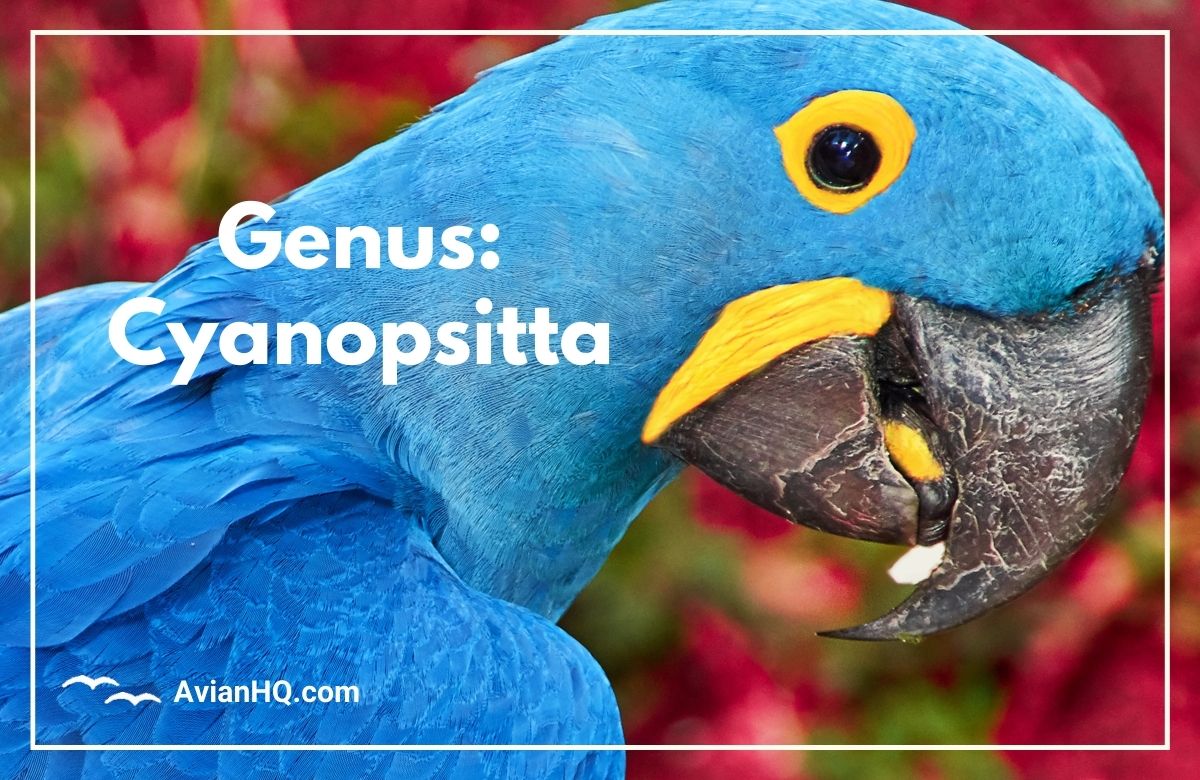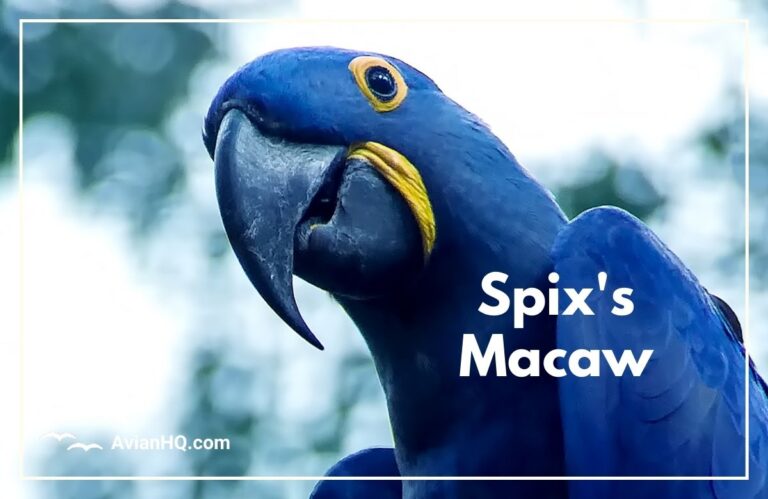Genus: Cyanopsitta
The vibrant blue feathers and bare facial patches make parrots in the genus Cyanopsitta stand out. But there is only one living species remaining in this genus today – the iconic Spix’s Macaw.
“The decline of Spix’s Macaw in the wild captures public imagination about protecting rare species.”
As the sole surviving member of the Cyanopsitta genus, understanding Spix’s Macaw offers insights into the evolution and conservation of these unique parrots. We spotlight key aspects of natural history, threats, and culture to appreciate these birds.
Why No Other Cyanopsitta Species Exist
Spix’s Macaw reigns as the single remaining Cyanopsitta species still found in nature. Previously, some taxonomists hypothesized additional Cyanopsitta species may have existed historically. However, current scientific consensus supports recognizing Cyanopsitta spixii as the single extant species in this genus.
Several factors explain the monopoly of Spix’s Macaw for the genus today:
- Specific habitat adaptations to flooded forest regions of interior Brazil
- Specialized feeding behaviors reliant on a few key palm trees
- Vulnerability to deforestation across its limited endemic range
In the future, advanced genetic analysis may reveal new insights. But for now, Spix’s Macaw persists as the sole representative of its kind on Earth. The precarious status of this species spotlights why protecting rare species matters.
Species Spotlights
Spix’s Macaw (Cyanopsitta spixii)
Physical Characteristics
- Length: 55-56 cm (21.7-22 inches)
- Weight: 500 grams (1.1 pounds)
- Bright blue feathers with various shades of azure, cobalt, and turquoise
- Bare facial patch of wrinkled gray skin around the eyes and beak
Historical Range and Habitat
Historically found in the Interior Forests and woodland savannahs of northeastern Brazil. Specifically the drainage basin of the Rio São Francisco in the states of Bahia and Piauí. Nesting occurred near rivers, streams and seasonal lakes situated among Mauritia flexuosa palm trees. Tigers
Current Conservation Status
- Critically Endangered
- Only an estimated 143 exist globally, all part of managed breeding populations.
- Extinct in the wild since 2000. Reintroduction efforts underway to revive a wild population.
Behavior and Intelligence
Social Behaviors
In the wild, Spix’s Macaws form small flocks and monogamous breeding pairs. Their loud nasal calls help keep the pairs together as they fly between nest sites and feeding grounds.
Foraging and Feeding
Specialized diet consisting mainly of seeds from Attalea eichleri and Acrocomia aculeata palms. Use their strong beaks to crack hard fruit and nuts. Also eat berries and greens from other plants.
Learning Ability and Intelligence
Spix’s Macaws are considered one of the most intelligent parrot species:
- Excellent memory for visual information and routes
- Fast acquisition of pattern recognition
- Young macaws mimic parental behaviors for identifying edible foods
- In managed care, they readily learn words, tricks and house training
- Play behaviors such as passing objects between feet indicate advanced cognitive abilities
Their intelligence and bonding instincts contribute to success in captive breeding programs – a key aspect of conservation efforts for the species. Understanding the cognitive abilities of this rare macaw sheds further light on its uniqueness.
Cultural Significance
Role in Indigenous Cultures
Spix’s Macaws held cultural significance for some Native peoples of interior Brazil, appearing in traditional songs, dances and legends. Their bright blue feathers were prized for ceremonial regalia. Historically they were likely kept as pets to some degree.
Prominence in Conservation and Environmental Movements
The dramatic decline of Spix’s Macaw in the wild fueled public interest in parrot conservation and habitat preservation globally. The species brought international attention to the consequences of large-scale deforestation occurring across Brazil. Its enigmatic beauty made it an ideal “poster child” for conservation groups.
Iconic Species Bringing Attention to Deforestation in Brazil
Images of Spix’s Macaw came to symbolize the vibrant – yet vulnerable – biodiversity of the Amazon region. Its extinction in the wild in 2000 was a wakeup call about protecting irreplaceable habitats. Ongoing reintroduction efforts remain high-profile news, partially due to this species’ prestige and history.
Threats and Conservation
Habitat Loss from Deforestation
Widespread clearing of forest for agriculture, logging and mining led to the departure of Spix’s Macaws from their native range by the 1980s. Loss of nesting palms and food sources likely drove initial population declines. By 2000, habitat destruction expelled the species entirely from the wild.
Illegal Pet Trade
Smugglers illegally captured Spix’s Macaws in the 1970s-80s to meet demand from exotic bird collectors. Estimates suggest 10-20 birds were removed from the wild this way, dealing another blow to the endangered wild population.
Conservation Breeding and Reintroduction Programs
Since the 1990s, cooperative global breeding programs expanded captive populations of Spix’s Macaws. Selective breeding and hand-rearing of chicks helped boost numbers. As of 2022, an estimated 143 birds exist in managed care around the world.
Ambitious initiatives are now working to return Spix’s Macaws to protected habitats in Brazil. Captive-bred birds are carefully trained in survival skills before release. If conservationists can establish safe wild breeding & feeding grounds, hope remains for revived wild populations.
Conclusion
Recap Key Details About the Genus
As we’ve explored, the Cyanopsitta genus contains just a single surviving species – the magnificent yet vulnerable Spix’s Macaw. Understanding the natural history, behaviors, threats and conservation status of this sole remaining macaw provides insights into the uniqueness of the genus.
The Importance of Protecting Rare Species
The dramatic decline of Spix’s Macaws in the wild spotlights the fragility of rare species, especially those endemic to specialized or threatened habitats. While captive breeding offers a lifeline, the costs of losing species in nature remain high. Protecting rare birds and other wildlife ensures richer biodiversity and ecosystems.
Hope for Future Species Recovery
Despite its fragility, Spix’s Macaws retain a devoted following among conservationists and macaw enthusiasts. Ongoing breeding initiatives continue boosting global population size. And recent reintroduction efforts may yet revive wild populations. So while challenges remain, there is hope for the future. Perhaps the blue skies over Brazil will once again ring with the cries of this rarest of macaws.


